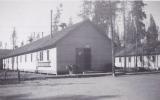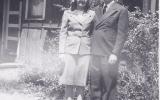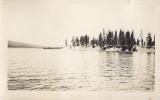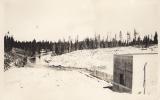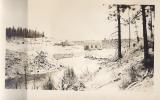CPS Unit Number 128-01
Camp: 128
Unit ID: 1
Operating agency: SSS
Opened: 1 1944
Closed: 12 1946
Workers
Total number of workers who worked in this camp: 310
-
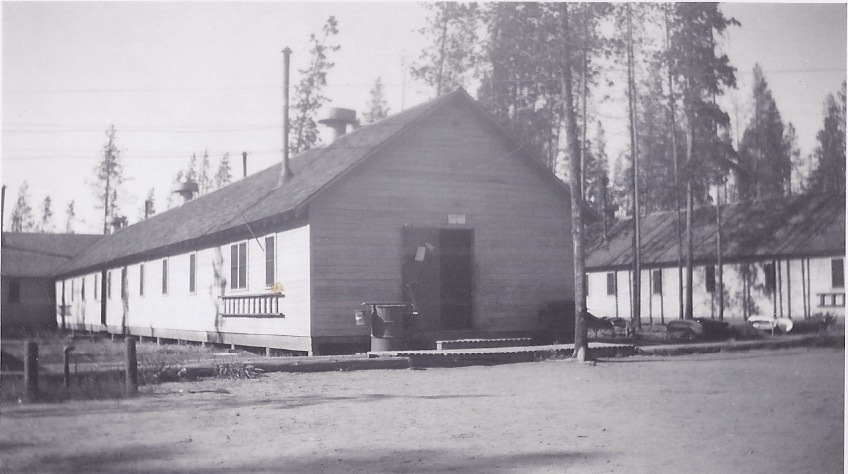 CPS Camp No. 60/No. 128Camp Wickiup dormitoryProvided by David P. Himes, son of Philip J. Himes.
CPS Camp No. 60/No. 128Camp Wickiup dormitoryProvided by David P. Himes, son of Philip J. Himes. -
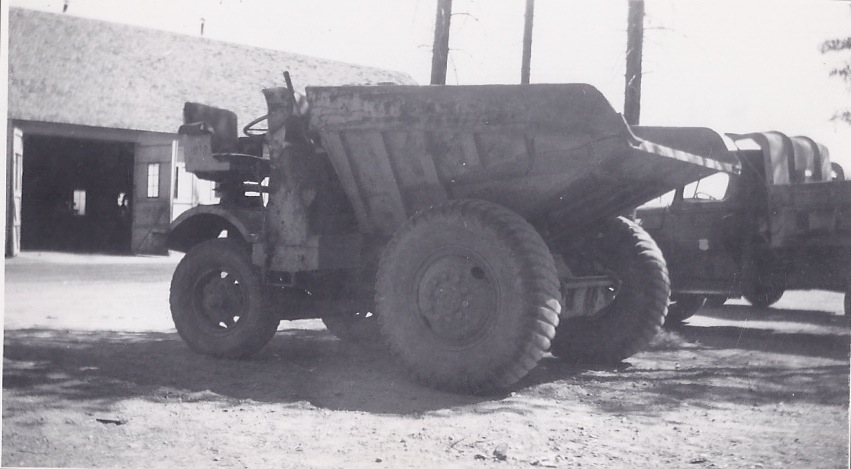 CPS Camp No. 60/No. 128Earth-moving trucks at Camp WickiupProvided by David P. Himes, son of Philip J. Himes.
CPS Camp No. 60/No. 128Earth-moving trucks at Camp WickiupProvided by David P. Himes, son of Philip J. Himes. -
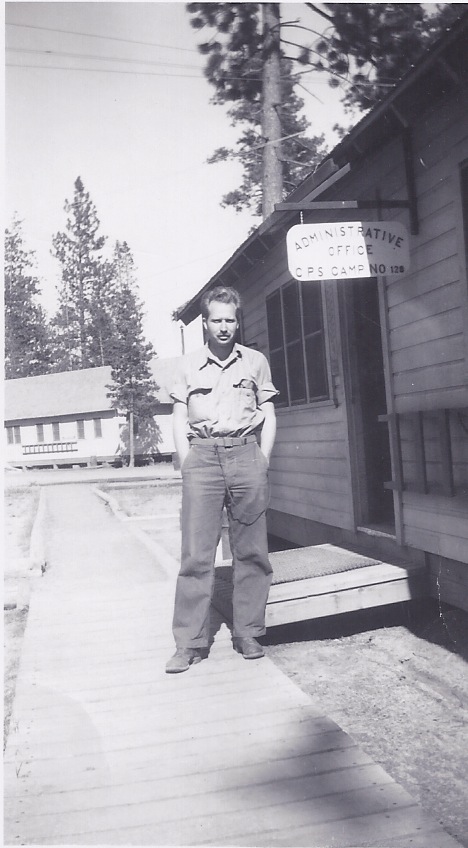 CPS Camp No. 128Philip J. Himes outside Administrative OfficeProvided by David P. Himes, son of Philip J. Himes.
CPS Camp No. 128Philip J. Himes outside Administrative OfficeProvided by David P. Himes, son of Philip J. Himes. -
 CPS Camp No. 60/No. 128Beatrice B. Himes and Philip J. HimesProvided by David P. Himes, son of Philip J. Himes.
CPS Camp No. 60/No. 128Beatrice B. Himes and Philip J. HimesProvided by David P. Himes, son of Philip J. Himes. -
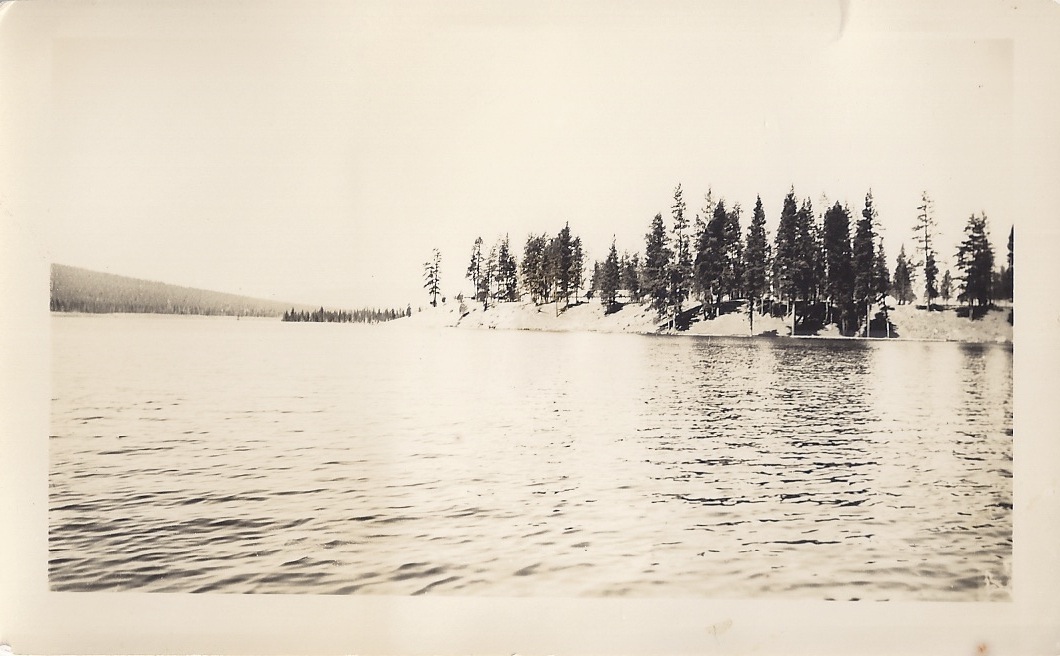 CPS Camp No. 60/No. 128Note on back by Philip J. Himes: "Although you can hardly see it, the camp is in this grove of trees. The camp is surrounded on three sides by the lake. The picture was taken looking up the lake toward the west. The dam is toward you and a little to the left about 2 miles down."Provided by David P. Himes, son of Philip J. Himes.
CPS Camp No. 60/No. 128Note on back by Philip J. Himes: "Although you can hardly see it, the camp is in this grove of trees. The camp is surrounded on three sides by the lake. The picture was taken looking up the lake toward the west. The dam is toward you and a little to the left about 2 miles down."Provided by David P. Himes, son of Philip J. Himes. -
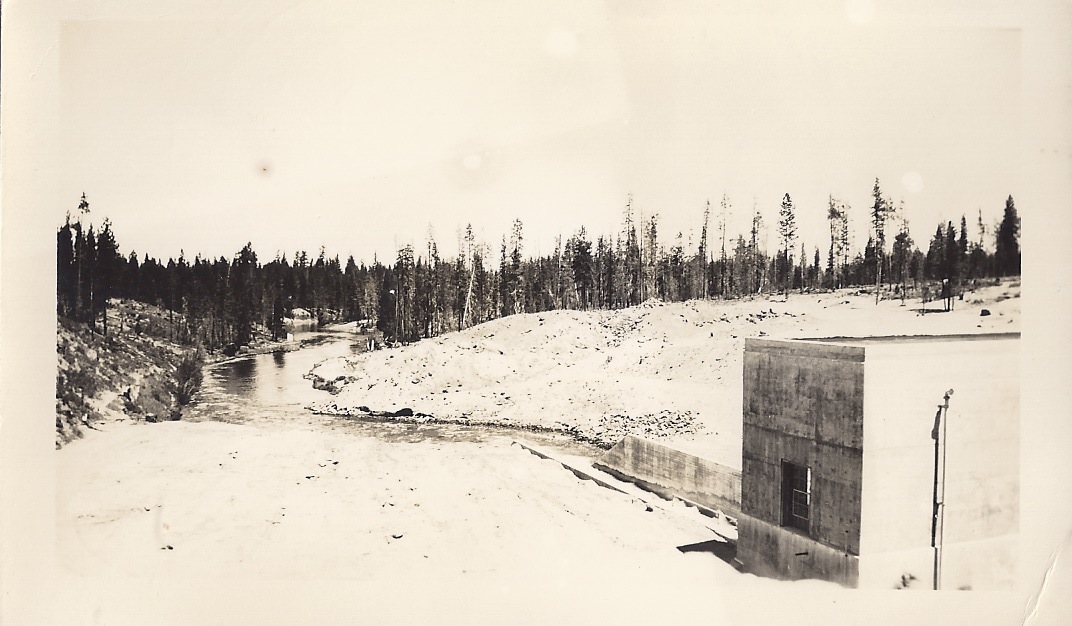 CPS Camp No. 60/No. 128Note on back by Philip J. Himes: "This was taken from the top of the dam looking down stream."Provided by David P. Himes, son of Philip J. Himes.
CPS Camp No. 60/No. 128Note on back by Philip J. Himes: "This was taken from the top of the dam looking down stream."Provided by David P. Himes, son of Philip J. Himes. -
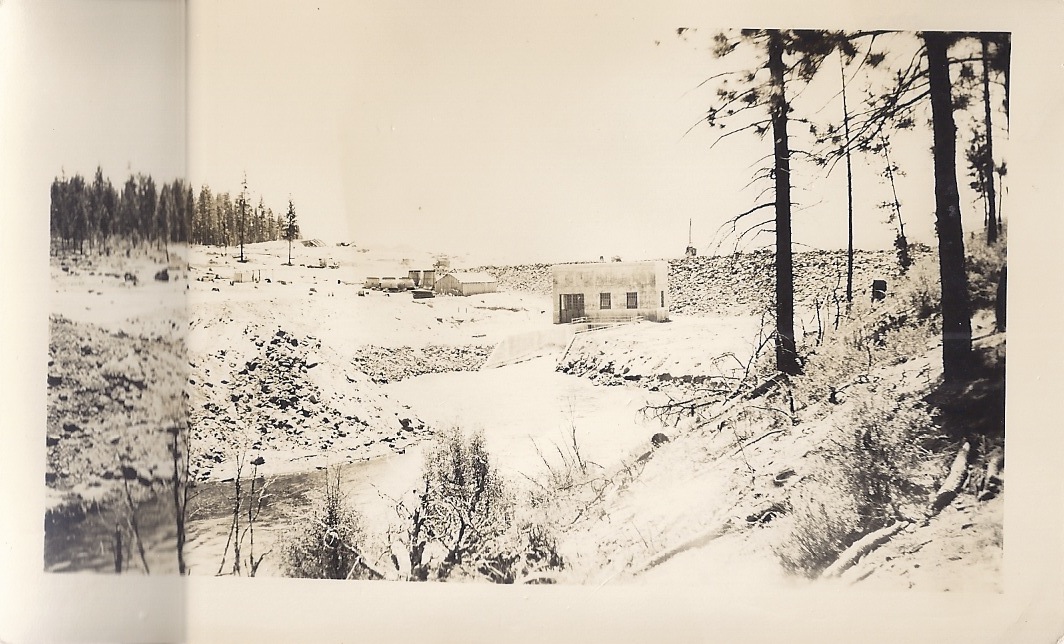 CPS Camp No. 60/No. 128Note on back by Philip J. Himes: "This is the back of the dam last year. The large cement building in the center is the valve house."Provided by David P. Himes, son of Philip J. Himes.
CPS Camp No. 60/No. 128Note on back by Philip J. Himes: "This is the back of the dam last year. The large cement building in the center is the valve house."Provided by David P. Himes, son of Philip J. Himes. -
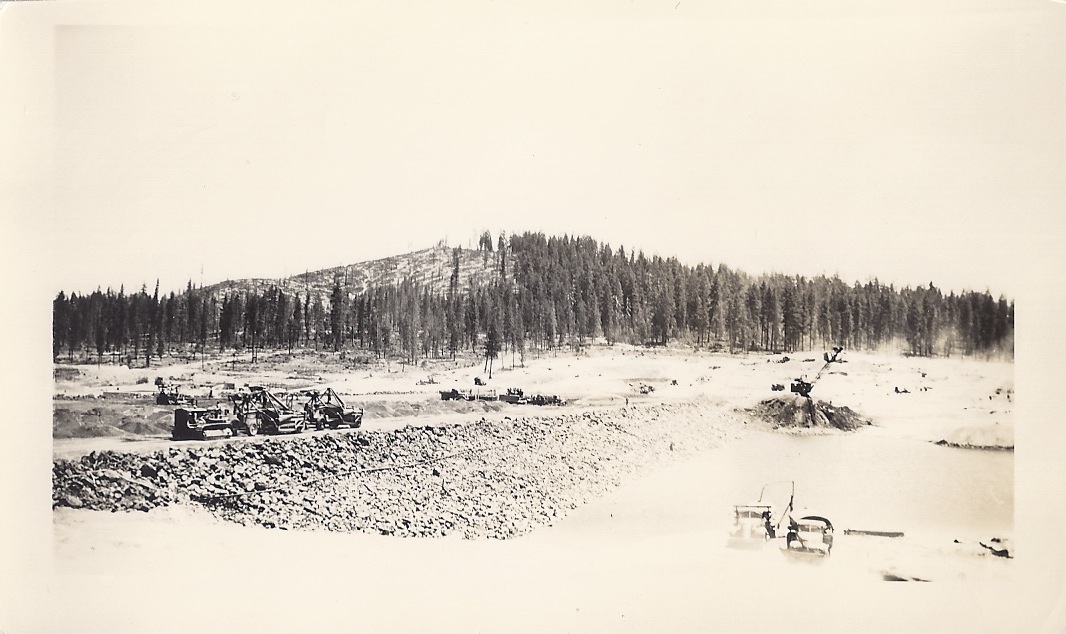 CPS Camp No. 60/No. 128Note on back by Philip J. Himes: "This is the front of the dam, last year. It is about twice that high now."Provided by David P. Himes, son of Philip J. Himes.
CPS Camp No. 60/No. 128Note on back by Philip J. Himes: "This is the front of the dam, last year. It is about twice that high now."Provided by David P. Himes, son of Philip J. Himes.
CPS Camp No. 128, a Bureau of Reclamation camp located in the former Civilian Conservation Corps camp near Lapine, Oregon opened in January 1944 as a government operated camp administered by Selective Service. The men continued work on the dam project on the upper DeRoches River until the camp closed in December 1946.
This camp was located in a Civilian Conservation Corps (CCC) camp built in 1938 near the Deschutes River about eighteen miles west of Lapine, Oregon. The buildings, arranged in three units, each of which could accommodate two hundred men, were in excellent condition.
“Lapine is located 18 miles from the village [of the same name]. . .and 16 miles from the highway, . . .through the woods on which there are no houses so there is no traffic, and this increases the isolation of the place.” (Report of visit by Charles Read, May 8, 1946)
The camp had been operated as camp #60 by the Mennonite Central Committee from December 1942 to January 1944. Selective Service took over the camp in January 1944 because they needed the large camp facility to accommodate the numbers of CPS men who had expressed a desire for work in government camps.
Directors: Herbert Murch
Some of the men requested transfer to a government camp in preference over a religiously administered camp. Others, however, were transferred to a government operated camp for one of several reasons—punishment for insubordination, unsatisfactory work, failure to choose a service agency, or medical observation. (Sibley and Jacob p. 249)
By 1945, one hundred and twenty-one COs comprised the camp.
A number of men walked out of this camp in 1945: Harold L. Barbee; Kenneth R. Bishop; Francis E. Boss; Amos K. Brokaw; George Hiram Brown; Wayne Brown; George H. Cleveland; Eugene Epp; Buster L. Gillman; Ray Knock; Philip J. Larson; Harold J. Lischner; Alex Penor; Frank Randall; Russell Shalkowski; Calvin Sigman; Kenneth D. Taylor; Willard (Bill) Womack; Rhodes Young. (Swarthmore College Peace Collection, American Friends Service Committee: Civilian Public Service Records (DG002) Section 1, Box 2c)
In 1938, the CCC began construction of a dam on the upper Deschutes River in the slopes of the Cascade Mountains to provide water for irrigation of fifty thousand fertile acres in central Oregon.
“Men at Lapine Camp are engaged in the construction of an earthfilled dam to store up water for transmission through a canal to the 10,000 acre area about 100 miles away which is being irrigated. . . In addition . . . men work on the canal, which presents such problems as the construction of an arch to carry water over the river and several tunneling operations.” (Report “What’s What at Lapine by Grover Hartman undated)
“There are about 100 men in camp, of whom about 20 work on project. . . .The project in winter is cutting wood to keep warm, and the work is very much slowed down.” (Charles Read)
The government paid for the men’s maintenance, medical and dental care, and clothing in addition to providing an allowance of five dollars per month. “I was amused by the fact that the men refer to their $5.00 monthly stipend as ‘the $5.00 monthly insult’.” (Charles Read, Report of May 8, 1946 visit)
Almost from the time they opened, the government operated camps experienced unrest and non-cooperation. The letter that follows communicates Edwin B. Bronner’s experience at Lapine.
This camp is a hole, I just couldn’t have believed that it is what it is before arriving here. My only experience with base camp was the six months at Elkton when it was the model camp of the system. . . . Work here at Lapine is past being a joke. . . .There are 20 men in the woods cutting wood to keep the fires going. Everyone else is on overhead. The wood cutting crew turns out maybe one cord of wood a day, that is, the entire 20 of them together cut one cord. There seems to be little effort on the part of anyone to get much done. The men in the kitchen work about 4 hours a day at the most. There are two men in one office where one fellow told me that he works hard for 3 days at the end of each month to turn out reports. As a result there is not a person in camp, administration included, who feels that the men are doing any significant work. When I arrived the director told me that the wood crew, where I was assigned, were clearing off land for the reservoir, and not to pay any attention to these people who said that we were just cutting wood to keep the camp warm. The same day he told a new foreman on the job that it was important to get the wood cut because if we didn’t cut six cords a day we wouldn’t keep the camp fires going. Foreman and all agree that as soon as the ground is a little harder the big equipment will go out and clear from one to two acres of the forest in a day. . . .
There is no organization of the men in camp at all. As a result rumors fly though the men a dozen a day. The administration makes no attempt to let the men know what is happening. . . .
The Oregon Federal courts are entirely too easy on walk-outs and other cases against COs, so SSS has had to figure out a scheme. Men have been getting 60 day sentences, suspended sentences, probation for 60 days and such things as that. Murch, camp director, has been told by the judge that he, the judge, will accept the word of the COs against Murch’s, and Murch has been laughed out of court on some of his cases against men. So, bad boys are now transferred to Minersville where they will be under Sacramento courts which are much stiffer. . . .
There are almost no recreational facilities. The Saturday night movies are unintelligible because the sound equipment is completely shot, and even so the machine breaks down completely at least twice every time used. . . .
There are some good things. There is a big lake in front of the camp. Some boating now, and swimming soon. The dorms are clean and comfortable, the food is better than at Elkton, but not served carefully. Men can go into town on week-ends, several have cars, and the truck goes in both Saturday and Sunday. Perhaps if work on the dam begins soon work morale will go up, because there would seem to be some use in such a project. However, the utter lack of rapport between the men and the administration precludes any real improvement of the situation. Singing songs about conscription, Kosch and Murch do not help relations. Foreman cussing out the yellow bellied slackers doesn’t help. Men feel that they are fighting hand to hand with conscription and SSS . . . Men feel that by slowing down on work they are proving that conscription won’t work. They aren’t, because they are transferred to Minersville, and they only develop inner bitterness which is unhealthy, and the contempt of the foremen. In the hate which some men have for the administration and SSS they are destroying themselves, it is pitiful to see what it is doing to some men. I feel that many will never recover, I hope I am wrong. (Letter from Edwin B. Bronner, April 6, 1945)
Charles Read, who visited the camp on May 8, 1946, reported on the camp life as follows.
There is no organized group life in the camp except for some Bible study by fundamentalist groups and JWs [Jehovah’s Witnesses], of whom there are a good many. The rest of the camp is rather disorganized, owing to the lack of capable leaders, I expect. . . . There are some athletics, but there is a bad lack of equipment. . . . The only regular expenditure is for a weekly third-rate movie. Murch selects the movies and they are exceedingly poor. . . . There is little desirable material in the library, and they have only a few magazines. . . . It seems likely that a number of men will walk out in case the draft act is extended.
Letter from Edwin B. Bronner, April 1, 1946. [In Box 2c of Section I, American Friends Service Committee: Civilian Public Service Records (DG 002), Swarthmore College Peace Collection]
Grover Hartman, “What’s What at Lapine”, undated report. Swarthmore College Peace Collection, American Friends Service Committee: Civilian Public Service Records (DG002) Section 1, Box 2c.
See Albert N. Keim and Grant M. Stoltzfus, The Politics of Conscience: The Historic Peace Churches and America at War, 1917-1955. Scottdale, PA: Herald Press, 1988.
Charles Read, Report of Visit May 8, 1946. Swarthmore College Peace Collection, American Friends Service Committee: Civilian Public Service Records (DG002) Section 1, Box 2c.
See Mitchell Lee Robinson, “Civilian Public Service in World War II: The Dilemmas of Conscience and Conscription in a Free Society”. Ph.D. dissertation, Cornell University 1990.
See Mulford Q. Sibley and Philip E. Jacob, Conscription of Conscience: The American State and the Conscientious Objector, 1940-47. Ithaca, NY: Cornell University Press, 1952, Chapter XI, Government Camps, pp. 242-256.
See also Steven J. Taylor, Acts of Conscience: World War II, Mental Institutions, and Religious Objectors. Syracuse, NY: Syracuse University Press, 2009, Chapter 6 A Working Compromise Between Church and State, pp. 103-138.
